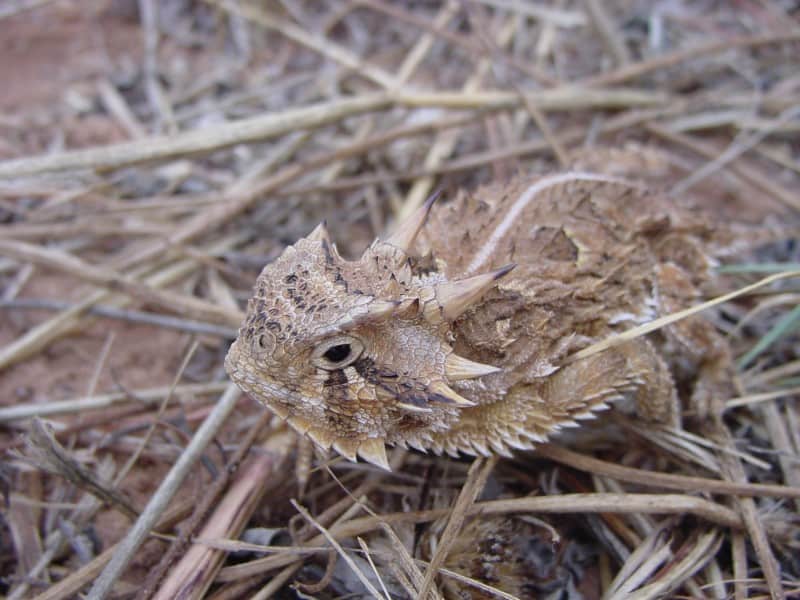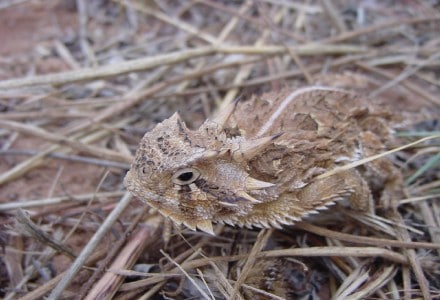
Texas Horned Lizard Facts
- First of all, the incredible animal commonly known as the Texas Horned Lizard truly remains a remarkably astonishing creature. The amazing reptile also forms one of the 14 known species of spike-bodied reptiles that evolved within its native range of habitation.
- Collectively, many people also know the different species within this group by several other common names. These other alternate names include the horned toad and the horned frog. However, the impressive group itself remains known by the name of horned lizards.
- Furthermore, this truly amazing animal historically played a key social role among some groups. That’s because some Native American peoples traditionally considered this animal to be sacred. Due to this, the various tribes often included the animal in much of their art.
- Finally, some humans previously kept the Texas Horned Lizard in captivity, as exotic pets. Quite fortunately, that practice is now illegal. Very sadly, and for various reasons, the distinctive species now holds a Threatened status with the IUCN, on its Red List of Threatened Species.
Related Articles
Komodo Dragon Tuatara Thorny Dragon
Public Domain Image
Texas Horned Lizard Physical Description
Although all species of horned lizard remain comparatively diminutive in size, the Texas Horned Lizard stands out. That holds true due to one specific fact. That’s because, in addition to its other unique attributes, this fascinating variety of lizard ranks as the largest of the species in its area.
The remarkable lizard also displays a moderate degree of sexual dimorphism in regards to size. The females attain a length of as much as 4.5 in (11.4 cm). Meanwhile, the smaller male reaches up to 3.7 in (9.4 cm) in length. The bodies also develop far more round in shape than most lizards.
Furthermore, its coloring displays a distinctive pattern that serves it well in terms of camouflage. This consists of a mottling of various shades of brown, gray, and black. The protruding horns of the Texas Horned Lizard also form surprising extensions of its skull and have a composition of solid bone.
- Kingdom: Animalia
- Phylum: Chordata
- Class: Reptilia
- Order: Squamata
- Family: Phrynosomatidae
- Genus: Phrynosoma
- Species: P. cornutum
Texas Horned Lizard Distribution, Habitat, and Ecology
Most notably, the Texas Horned Lizard evolved as native to a specific area of North America. To be precise, that area of habitation includes Kansas, Colorado, Arizona, Texas, and northern Mexico, in the United States. Humans have also introduced it into Georgia, Florida, and the Carolinas.
Further, despite its rather fearsome appearance, the creature remains remarkably docile. Wild individuals will sit calmly in one’s hand. However, this level of docility obviously presents dangers for the lizard. In addition, individuals rarely bite, unless they feel themselves to be directly threatened.
Furthermore, the impressive animal evolved a diet very similar to many related species. As a result, it remains entirely insectivorous and feeds primarily on harvester ants. However, it will also feed opportunistically on a variety of other insects, especially if its preferred prey remains scarce.
Additionally, the amazing Texas Horned Lizard also developed a highly unusual defense mechanism. That’s because individuals can project an aimed stream of blood from the corners of the eyes, and from the mouth as well. Finally, this blood is also mixed with a chemical to make it extremely foul-tasting.
Species Sharing Its Range
Carolina Wolf Spider Volcano Rabbit Old Woman Cactus
Check out our other articles on 6 Fabulous European Lepidoptera, African Penguin, Moeraki Boulders, Vietnamese Mossy Frog, Rainbow Eucalyptus, Giant Freshwater Prawn,

